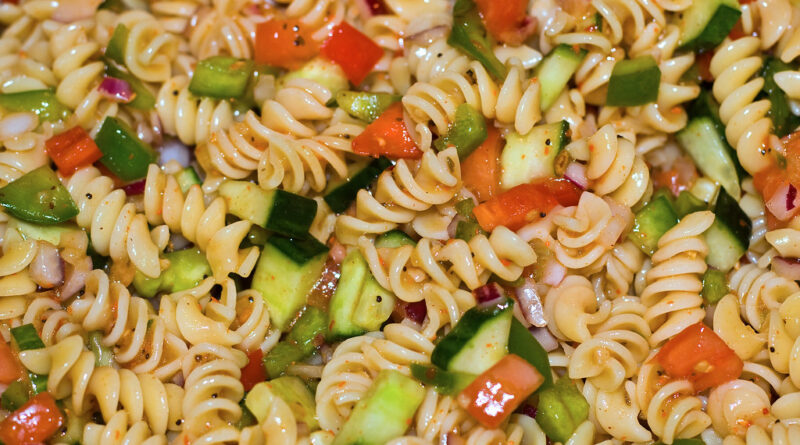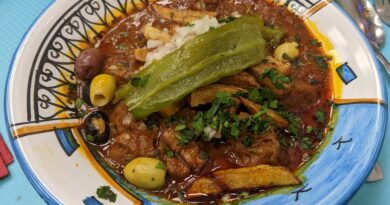Pasta salad
Pasta Salad: A Symphony of Flavors and Textures
When it comes to versatile and satisfying dishes, few can match the allure of a well-made pasta salad. This culinary creation combines the comfort of pasta with the vibrancy of fresh vegetables, the richness of dressings, and the depth of flavors from various ingredients. Whether served as a side dish, a main course, or even at a picnic, pasta salad has found its way into countless kitchens and hearts around the world. Join us on a culinary journey as we explore the history, preparation, and endless possibilities of pasta salad.
The Origins of Pasta Salad
Pasta salad, in its modern form, is a relatively recent addition to the world of culinary delights. Its origins can be traced back to the United States in the early 20th century. While pasta itself has been a staple in Italian cuisine for centuries, the concept of combining cooked pasta with vegetables, dressings, and seasonings to create a cold salad is a more recent innovation.
Early Pasta Salads
Early versions of pasta salad often featured simple ingredients like macaroni, mayonnaise, and vegetables, such as celery and onions. These salads were served as side dishes and were popular at picnics and social gatherings.
Evolving Over Time
As pasta salad gained popularity in the United States, its ingredients and variations began to expand. Italian pasta shapes like fusilli, rotini, and penne became common choices. Dressings evolved beyond mayonnaise, with vinaigrettes, pesto, and various sauces offering a wider range of flavors.
The Ingredients That Create Magic
One of the defining characteristics of pasta salad is its versatility. While there are classic recipes, the possibilities are nearly endless, allowing for personal creativity and adaptation. However, there are several core components that come together to create the magic of pasta salad:
Pasta
The choice of pasta is crucial, and various shapes offer different textures and experiences. Short pasta like fusilli, farfalle (bowtie), or penne are popular choices due to their ability to hold dressings and ingredients.
Vegetables
Fresh vegetables add color, texture, and nutrition. Common options include cherry tomatoes, bell peppers, cucumbers, red onions, and olives. However, feel free to incorporate your favorite seasonal vegetables.
Proteins
Proteins such as grilled chicken, shrimp, salami, or chickpeas can be added for heartiness and flavor. They turn pasta salad into a substantial meal.
Dressing
The dressing is where you can get creative. Classic dressings include Italian vinaigrette, ranch, or Caesar. Pesto, balsamic glaze, or yogurt-based dressings are excellent choices as well.
Cheese
Cheese adds richness and a burst of flavor. Options like feta, mozzarella, or Parmesan work beautifully.
Fresh Herbs
Fresh herbs like basil, parsley, or cilantro lend a burst of freshness and aroma to the salad.
Seasonings
Seasonings like salt, pepper, garlic, and red pepper flakes are used to balance and enhance the flavors.
Crafting the Perfect Pasta Salad
The art of crafting a perfect pasta salad lies in achieving a harmonious balance of flavors, textures, and ingredients. Here’s a step-by-step guide to creating your own:
Step 1: Cook the Pasta
- Start by cooking the pasta according to the package instructions. Be sure to cook it al dente, as the pasta will continue to absorb flavors from the salad.
Step 2: Prepare the Ingredients
- While the pasta is cooking, prepare the vegetables, proteins, cheese, and herbs. Chop and dice them into bite-sized pieces for easy eating.
Step 3: Make the Dressing
- In a separate bowl, prepare the dressing by whisking together the chosen oil, vinegar or citrus juice, seasonings, and any desired flavor enhancers like garlic or mustard.
Step 4: Combine and Toss
- Once the pasta is cooked and drained, place it in a large mixing bowl.
- Add the prepared vegetables, proteins, cheese, and herbs to the pasta.
- Pour the dressing over the ingredients and gently toss everything together until well-coated.
Step 5: Refrigerate
- Cover the pasta salad and refrigerate it for at least an hour before serving. This allows the flavors to meld and develop.
Step 6: Garnish and Serve
- Just before serving, garnish the pasta salad with additional herbs, cheese, or a drizzle of dressing for extra flavor.
Pasta Salad Variations
The beauty of pasta salad is that you can customize it to suit your taste and dietary preferences. Here are some popular variations from around the world:
Greek Pasta Salad
Greek pasta salad typically includes feta cheese, Kalamata olives, cherry tomatoes, cucumbers, red onions, and a Greek vinaigrette.
Caprese Pasta Salad
Inspired by the classic Caprese salad, this variation features cherry tomatoes, fresh mozzarella, basil, and balsamic glaze.
Asian-Inspired Pasta Salad
This version incorporates ingredients like edamame, shredded carrots, bell peppers, and a soy-based dressing with sesame oil and ginger.
Mediterranean Pasta Salad
Mediterranean pasta salad includes ingredients like artichoke hearts, roasted red peppers, olives, and a lemon-oregano dressing.
Southwestern Pasta Salad
For a spicy twist, add black beans, corn, avocado, and a chipotle-lime dressing.
The Cultural Significance of Pasta Salad
Pasta salad may have originated in the United States, but its appeal has spread far and wide, transcending borders and cultures. Its adaptability and capacity to accommodate a wide range of ingredients make it a favorite in various cuisines.
The American Picnic Classic
In the United States, pasta salad has become synonymous with outdoor gatherings, picnics, and barbecues. It’s a beloved side dish that complements grilled meats and burgers perfectly.
The Italian Connection
While pasta salad may have American origins, it maintains a connection to its Italian roots through the use of Italian pasta shapes and ingredients like olive oil, cheese, and fresh herbs.
Global Inspiration
Pasta salads are made in diverse ways across the globe, drawing inspiration from local ingredients and flavor profiles. In each culture, it adapts to reflect the culinary traditions and tastes of the region.
Pasta Salad: A Year-Round Delight
Pasta salad is a versatile dish that can be enjoyed year-round. In the summertime, it’s a refreshing and cool option, ideal for picnics and outdoor dining. During the colder months, pasta salad can be served warm or at room temperature, making it a satisfying and hearty meal.
The Pleasure of Pasta Salad
What is it about pasta salad that makes it such a universally loved dish? It’s the combination of flavors, textures, and versatility that appeals to a wide range of palates. Pasta provides the comforting base, while vegetables, proteins, and dressings add layers of complexity and satisfaction. It’s a dish that can be as light or as hearty as you desire, making it suitable for any occasion.
Pasta salad also offers a unique opportunity for creativity in the kitchen. You can experiment with different ingredients, flavors, and textures to create a pasta salad that is uniquely yours. It’s a canvas for culinary expression, allowing you to showcase seasonal produce and your personal taste.
Conclusion
Pasta salad is more than just a dish; it’s a celebration of simplicity and versatility. It’s a reminder that a handful of ingredients when combined with care and creativity, can yield a delightful and satisfying meal. Whether you enjoy it as a side dish, a main course, or a picnic favorite, pasta salad has earned its place as a timeless classic in the world of culinary delights. So, the next time you prepare a pasta salad, savor not only the flavors but the endless possibilities that this dish brings to your table and your palate.



